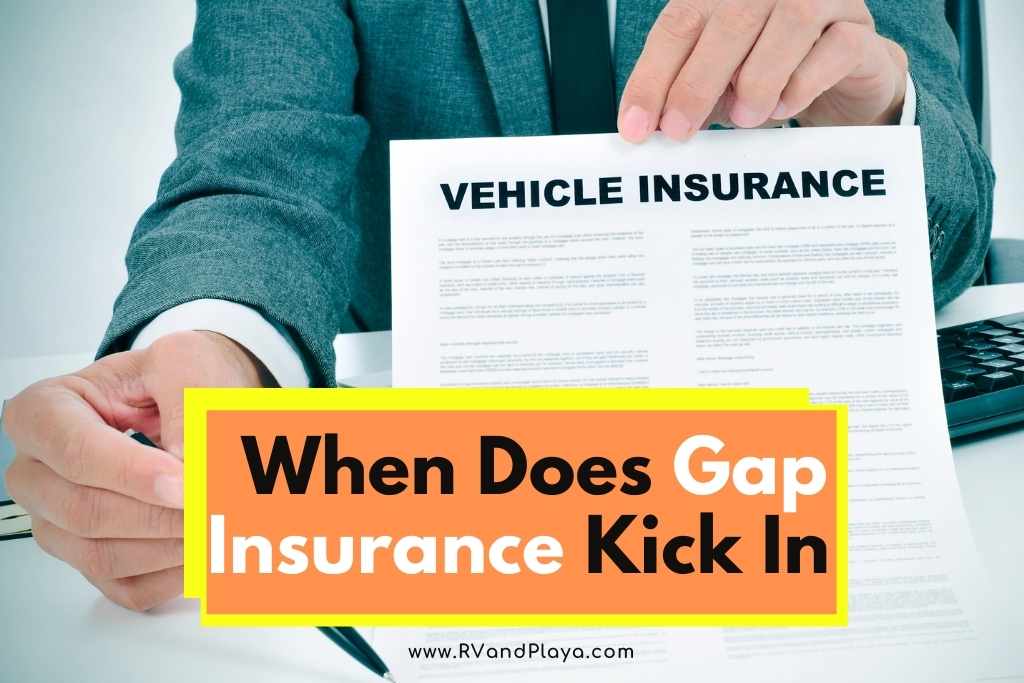Do you know when does gap insurance kicks in? this is one of the questions our readers ask a lot. Well, we´ve got you covered.
Gap insurance is typically something that you only get when you purchase a brand new vehicle.
You can purchase gap coverage, often at a lower rate, later in the vehicle’s history, however, it isn’t always offered, and it depends on the insurance company.
So, when does gap insurance kick in? Gap coverage kicks in if you have totaled your vehicle, or it has been stolen and you still owe money on that vehicle. More specifically, gap coverage pays for the difference between the depreciated value of your vehicle and the total amount that you owe.
Let’s say that you purchase a vehicle for $20,000 and your insurance includes gap coverage. You get into an accident that totals the vehicle and the worth of the vehicle—prior to it being totaled—is $14,000. Let’s say you still owe $15,000. Gap coverage will pay the $1,000 difference.
If you owe more on a vehicle than its depreciated value and you total the vehicle, that’s where gap coverage kicks in, to cover that gap between what you owe and what it was worth before it met its unfortunate demise.
Table of Contents
Is Gap Coverage Worth It?
If you’re purchasing a new vehicle, and you plan on making monthly payments, most state laws require you to carry full coverage insurance until the day that the vehicle is paid off.
Since you’re already paying full coverage, you might as well grab gap coverage while you’re at it.
There are two reasons for this. First, it’s a difficult coverage option to get later on down the road. As aforementioned, not every insurance company offers it if you didn’t pick it up when you purchased the vehicle at the dealership.
Second, the average depreciation on cars is quite a bit. In fact, it’s roughly 50% over a five-year period.
There’s an interesting website calculator available for you to plug in your make, model, and year to get a bird’s-eye view of the depreciation level on your vehicle.
The sad fact is, almost every vehicle depreciates quickly, more so with some vehicles and less with others.
The point is, a vehicle can depreciate in value far quicker than the actual cost of the vehicle as you’re paying on it monthly.
A $20,000 vehicle—on average—will be valued at $16,200 after a single year has passed. That’s a $3,800 drop in only 365 days.
That means your vehicle’s value is dropping $10.41 per day, on average.
Kind of depressing, isn’t it? Hybrids have an enormous depreciation value as well as some electric models.
If you happen to be the proud new owner of a Nissan Leaf, Chevy Volt, or BMW 7 Series, your vehicle will depreciate just over 70% in two years.
If your payments aren’t going to keep pace with the depreciation value of the vehicle you’re buying, then it’s a good idea to purchase gap coverage in the unfortunate event of an accident that totals your vehicle.
Read also: Is RV GAP Insurance Worth It? [Guide for Nationwide Camper & RV]
How Is Gap Coverage Determined?
Each state has its own regulations on what defines “totaled” or when a vehicle is considered a total loss. Usually, it means that in order to repair the vehicle, you would end up spending more than the sum total of its value.
So even if it is repairable, if it costs more to repair it than the vehicle is worth, it is considered totaled. Keep in mind, that’s just an explanation of one facet of the determination process for what constitutes a totaled vehicle.
Every state is different, though some may have similar procedures.
Regardless, your auto insurance company will send out a vehicle inspector, and if your vehicle meets the standards of what your insurance company—and what they are authorized to consider under your state’s laws—considers “totaled,” the inspector will give the go-ahead for your gap coverage to kick in.
The inspecting agent will also determine what your car’s fair market value is, after calculating depreciation, the vehicle’s history prior to the accident, and anything that was wrong with the vehicle prior to the accident.
Keep in mind, the gap coverage amount will not be sent to you but rather to the lienholder of your vehicle.
If you still owe $10,000 on the vehicle that was totaled and its fair market value is set at $8,250, your insurance company will send the $1,750 to whoever it is that you owe, whether that is a dealership or a private party.
Read also: When Does Gap Insurance Not Pay (9 True Reasons)
Do You Still Need Gap Insurance If You Have Full Coverage?
Full coverage doesn’t necessarily include gap coverage. In fact, it never does. When you purchase a brand new car from the dealership, gap coverage is an option that should be offered.
Unfortunately, it’s probably not something that is often considered right up front but any insurance agent worth their salt should bring it up, offer it, and explain what gap coverage is and what all it entails.
As stated before, you should always calculate your vehicle payments against the rate of depreciation.
You should also strongly consider purchasing a vehicle that has a low depreciation rate so that your payments keep up or surpass the rate of depreciation.
The following vehicles have some of the lowest rates of depreciation:
- Jeep Wrangler ; Jeep Wrangler Unlimited – 9.2%
- Toyota Tacoma – 13.8%
- Ford Mustang – 21.0%
- Toyota 4-Runner – 24.6%
- Subaru WR-X – 38%
Those are values based on five years of ownership. With the average depreciation percentage hovering between 40% and 50%, its hard to beat the vehicles listed above.
The next list includes the vehicles that depreciate the most over a five year period:
- Nissan Leaf – 70%
- BMW i3 – 63.1%
- BMW 5 Series – 59.1%
- Audi A6 – 58.2%
- Lincoln Navigator – 57.7%
When you sit down and determine the options that you want to add to your full coverage insurance, consider the vehicle that you’re purchasing, the total depreciation value over a five-year period, and your monthly payments.
You can use those factors to determine whether or not gap coverage is what’s best for you.
IF you discover that you can’t pay the vehicle off faster than it depreciates, you should strongly consider adding gap coverage.
Read also: Does Esurance Have Gap Insurance (Lease Coverage & Quotes)
Is Gap Insurance A Waste Of Money?
It largely depends on how fast your vehicle depreciates, how much you’re going to pay monthly, and your insurance company’s reputation.
Everyone knows how insurance tends to work. When Hurricane Ivan hit the Pensacola, Florida area in 2004, Pensacola was unprepared and many were lost the roof of their homes.
When insurance inspectors moved in, people quickly discovered that words can easily be twisted. Since some people lost their roofs, the heavy rains flooded their homes.
Insurance companies chalked that up to “flood” damage, even though these areas weren’t flooded.
Since most people had coverage against hurricanes but not flood insurance, those insurance companies wouldn’t cover the damage to their homes, despite the fact that these areas didn’t flood.
The moral of the story is, pick a reliable insurance company and always pay close attention to the fine print.
Read also: Is Car Insurance a Waste of Money? (The Truth – Nobody Is Talking About!)
Last But Not Least
Gap insurance can be very meaningful if you calculate the costs versus the vehicle’s depreciation.
A good insurance company, that’s reliable, and straightforward will cover the gap between your loss and what you owe.
If you happen to end up in an unfortunate situation where your vehicle is totaled, you may appreciate the fact that you took the time to crunch the numbers and determined to purchase gap insurance.
Here are some of my favorite services, products, and Stores
I created this resource page to easily list recommended services, products, and companies that I use and/or those I know are valuable.
This way you can quickly find great products and services all in one place. You can save thousands of dollars all from one page!
There are affiliate links, so if you do decide to use any of them, I´ll earn a small commission. But in all honesty, these are the exact what I use and recommend to everyone, even my own family.
+ Products & Services
+ Earn More
+ Save Thousands of Dollars
+ Live More
References
https://www.allstate.com/tr/car-insurance/gap-insurance-coverage.aspx
https://www.omnicalculator.com/finance/car-depreciation
Recent Posts
How Much Does Car Insurance Go Down After 1 Year with No Claims?
Wondering how much your car insurance goes down after a year with no claims? Well, you've found the right place. You may well be surprised by just how much you can save by keeping safe on the road...
Have you ever wondered when does gap insurance will not pay you? Well, look no more. We´ve got you covered. Gap cover insurance is a vital option when your vehicle's book value is less than the...


